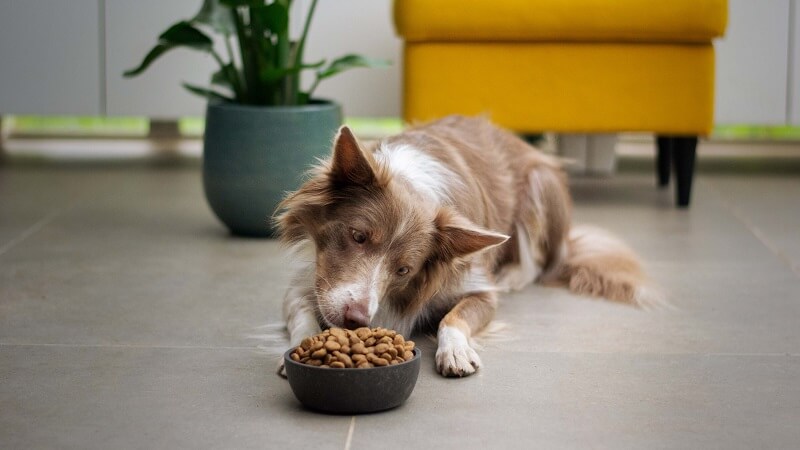
Dog Puzzle Feeder vs Interactive Toys: Which Is Best For Your Pooch?
Choosing the right plaything for your furry friend – be it a dog puzzle feeder or interactive toys – is essential for their mental and

Are you tired of your dog’s lightning-fast eating habits that often lead to tummy troubles or sheer boredom? That’s where the magic of a puzzle feeder comes in!
These remarkable contraptions not only slow down your pup’s mealtime but also provide mental stimulation and entertainment.
But before you embark on your DIY puzzle feeder project, you need to pick the right materials.
In this guide, we’ll explore the art of material selection, ensuring a safe, effective, and pawsitively enjoyable experience for your four-legged companion.
First things first: safety! You wouldn’t want your dog munching on something harmful. Let’s dive into selecting materials that will keep your furry friend out of harm’s way.
When choosing materials, opt for non-toxic options that are safe for your pet to chew on. Avoid anything that might splinter or break into small, swallowable pieces.
Check for any sharp edges or parts that could pose a choking hazard. Remember, safety is paramount when it comes to crafting DIY toys for your dog.
One of the safest materials you can choose for your DIY puzzle feeder is food-grade silicone. It’s non-toxic, durable, and easy to clean.
Food-grade silicone is commonly used in kitchenware and is designed to withstand contact with food. Your dog can safely interact with it, and you can easily sanitize it after each use.
Your DIY puzzle feeder should be up to the challenge, enduring your dog’s boundless enthusiasm.
It’s essential to choose materials that can withstand both the physical wear and tear and the inevitable slobber. Look for options that are easy to clean, as food residues can accumulate over time.
Consider materials like sturdy plastics or food-grade silicone.
These materials are not only durable but also easy to wipe down or toss in the dishwasher for a thorough cleaning. A clean puzzle feeder ensures your dog enjoys a hygienic dining experience every time.
Another excellent choice for durability is stainless steel. Stainless steel bowls are widely used for dog food and water dishes due to their resilience and ease of cleaning.
While you might not create an entire puzzle feeder from stainless steel, you can incorporate stainless steel bowls into your DIY design for added durability.
To transform a simple feeding routine into an engaging puzzle, your chosen materials should offer the right texture and structure.
Think about how these materials can hold food in a way that requires your dog to work for their meal.
Materials with nooks and crannies, grooves, or compartments can be perfect for hiding kibble or treats.
This added complexity will challenge your dog’s problem-solving skills while making mealtime an entertaining endeavor.
Consider materials like rubbery textures, which can provide a gripping surface for your dog to manipulate.
Some DIY puzzle feeders even incorporate elements like PVC pipe connectors to create intricate mazes for food.
When exploring materials, you might encounter terms like “thermoplastic elastomer” or “TPR.” These materials are often used in pet toys and accessories due to their durability and flexibility.
Thermoplastic elastomers are a type of synthetic rubber that can provide the texture and resilience needed for a successful DIY puzzle feeder.
While crafting a DIY puzzle feeder can be a cost-effective solution, it’s essential to keep accessibility and budget in mind when choosing materials.
Look for materials that are readily available at your local hardware store or online retailers. This ensures you can easily acquire what you need to bring your puzzle feeder to life.
Commonly available materials include PVC pipes, PVC connectors, PVC caps, food-grade silicone molds, and even simple items like cardboard boxes and empty plastic bottles.
These materials are often affordable and accessible, making them excellent choices for your DIY project.
Cost-effectiveness is also a crucial factor.
While it’s tempting to go all out with extravagant materials, remember that a simple yet clever design can be just as effective and budget-friendly.
After all, it’s the mental stimulation and enjoyment that matter most to your dog.
Materials are versatile! Don’t limit yourself to conventional choices. Consider unconventional options that could make your puzzle feeder a unique creation.
Think about repurposing items like old muffin tins, PVC pipes, or even cardboard boxes.
These materials can be transformed into engaging puzzle feeders with a bit of ingenuity. PVC pipes, for example, can be cut and assembled to create a maze-like structure for food.
Repurposing everyday items not only adds an eco-friendly touch to your project but also showcases your creativity in providing mental stimulation for your dog.
When thinking about unconventional materials, you might come across terms like “upcycling.”
Upcycling involves repurposing old or discarded items into something new and valuable.
It’s an eco-friendly approach to crafting and can result in a one-of-a-kind puzzle feeder that your dog will adore.
The best way to understand material selection for a DIY puzzle feeder is through practical examples.
Let’s explore a few real-world DIY puzzle feeder projects, complete with suggestions on how to assemble them using the chosen materials.
Materials:
How to Assemble:
The tennis balls create an enticing treat-dispensing puzzle. Your dog will have to figure out how to remove the balls to access the hidden treasures beneath.
Materials:
How to Assemble:
This PVC pipe maze can be adjusted to increase the difficulty level, keeping your dog mentally engaged during mealtime.
Materials:
How to Assemble:
Your dog will have to figure out how to access the treats hidden within the cardboard box compartments. This DIY puzzle feeder is perfect for dogs who enjoy a tactile challenge.
Safety remains a top priority throughout your DIY puzzle feeder journey.
While crafting, ensure there are no loose parts that your dog could accidentally ingest.
Regularly inspect the puzzle feeder for wear and tear, replacing any damaged materials promptly.
When introducing your dog to the puzzle feeder, supervise their interactions until you’re confident they understand how it works.
Safety and a positive experience should always go paw in paw.
As you venture into the world of DIY puzzle feeders, remember that selecting the right materials is the first step toward creating an engaging and mentally stimulating mealtime experience for your beloved pup. Safety, durability, and creativity are your guiding principles.
So, roll up your sleeves, gather your materials, and embark on a journey that will not only slow down your dog’s eating but also fill their days with entertainment and mental enrichment.
Creating a DIY puzzle feeder isn’t just a fun project; it’s a way to bond with your dog and enhance their overall well-being.
Your dog will thank you with every delicious and thought-provoking bite, and you’ll both enjoy the satisfaction of a puzzle well-solved!


Choosing the right plaything for your furry friend – be it a dog puzzle feeder or interactive toys – is essential for their mental and

Wondering if a puzzle feeder could revolutionize your pet’s mealtime into an exciting challenge? This unique device promises to engage your furry friend both mentally

For passionate pet enthusiasts, a puzzle feeder is more than just a toy; it’s a critical tool for mental stimulation and dietary control for their

Are you ready to dive deeper into the world of puzzle feeder and embark on a journey to ensure your furry friends remain mentally stimulated?

Choosing the right plaything for your furry friend – be it a dog puzzle feeder or interactive toys – is essential for their mental and

Wondering if a puzzle feeder could revolutionize your pet’s mealtime into an exciting challenge? This unique device promises to engage your furry friend both mentally

For passionate pet enthusiasts, a puzzle feeder is more than just a toy; it’s a critical tool for mental stimulation and dietary control for their

Are you ready to dive deeper into the world of puzzle feeder and embark on a journey to ensure your furry friends remain mentally stimulated?
Copyright © 2024 puppypuzzlefeeder. All Rights Reserved.